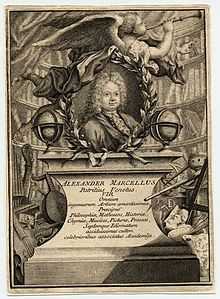Alessandro Marcello

Alessandro Ignazio Marcello (Italian: [marˈtʃɛllo]; 1 February 1673[1] in Venice – 19 June 1747[2] in Venice) was an Italian nobleman and musician.
Biography
A contemporary of Tomaso Albinoni, Marcello was the son of a senator in Venice. As such, he enjoyed a comfortable life that gave him the scope to pursue his interest in music. He held concerts in his hometown and also composed and published several sets of concertos, including six concertos under the title of La Cetra (The Lyre), as well as cantatas, arias, canzonets, and violin sonatas. Marcello, being a slightly older contemporary of Antonio Vivaldi, often composed under the pseudonym Eterio Stinfalico, his name as a member of the celebrated Arcadian Academy (Pontificia Accademia degli Arcadi). He died in Padua in 1747.
Alessandro's brother was Benedetto Marcello, also a composer, who illegally married his singing student Rosanna Scalfi in 1728. After his death she was unable to inherit his estate, and in 1742 she filed suit against Alessandro Marcello, seeking financial support.[3]
Works
Although his works are infrequently performed today, Marcello is regarded as a very competent composer. His La Cetra concertos are "unusual for their wind solo parts, concision and use of counterpoint within a broadly Vivaldian style," according to Grove, "placing them as a last outpost of the classic Venetian Baroque concerto."
A concerto, op 1. Marcello wrote in D minor for oboe, strings and basso continuo is perhaps his best-known work. Its worth was affirmed by Johann Sebastian Bach who transcribed it for harpsichord (BWV 974). A number of editions have been published of the famous Oboe Concerto in D minor. The edition in C minor is credited to Benedetto Marcello.
Notes and references
- ↑ [MARCELLO, Alessandro Ignazio. - Fratello maggiore di Benedetto, nacque a Venezia il 1° febbr. 1673, primogenito di Agostino, del ramo alla Maddalena, e di Paolina Cappello S. Lunardo, patrizi veneti. La data di nascita - 24 ag. 1669 -, riportata nelle genealogie familiari e accolta nelle più recenti enciclopedie, è in realtà quella di un fratello omonimo, scomparso in età infantile; è lo stesso M., in un epigramma latino intitolato De sua genitura, a confermare i dati riscontrabili nella fede battesimale. Treccani]
- ↑ Marcello's birth/death dates are given as 1684 to 1750 in The Grove Dictionary of Music and Musicians.
- ↑ Sadie, Julie Anne; Samuel, Rhian (1994). The Norton/Grove dictionary of women composers (digitized online by GoogleBooks). Retrieved 4 October 2010.
Sources
- The Grove Concise Dictionary of Music, Oxford University Press, 1994.
External links
|